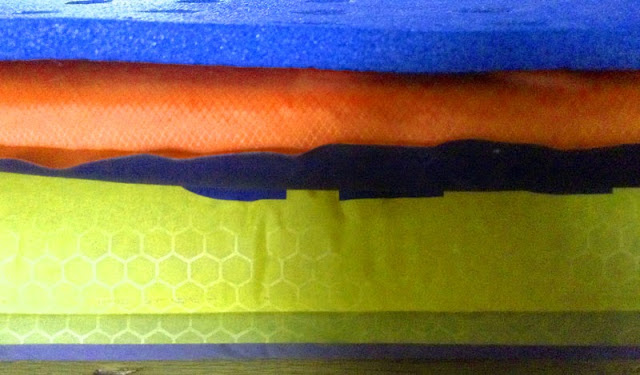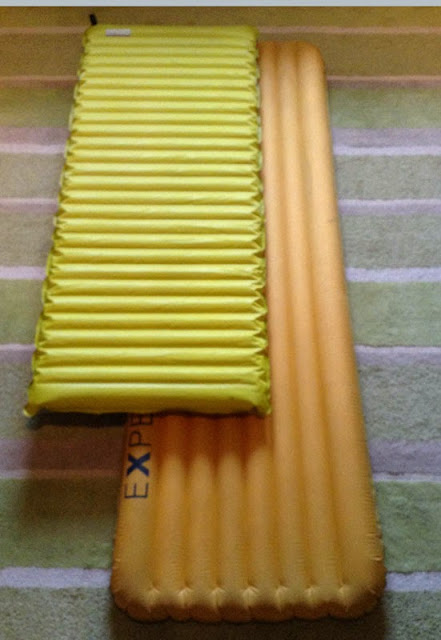When you’re all giddy and excited trying to decide what sleeping kit to buy, it’s very easy to overlook the seemingly humble sleeping mat, it’s often overshadowed by the more glamorous sleeping and bivvy bags … but at 3.00am when the mercury’s hovering around minus five, you might find yourself wishing you’d paid it a little more attention.
The thing we need to remember is that you lose more heat to the floor via conduction than you will to the air above and around you via the magic that is convection. Insulating you from the cold ground is your mats primary role, obviously it also helps make a night lay on the hard ground a more comfortable one than it might otherwise be. Although that comfort is something we value highly, in reality it’s really just a secondary function.
There’s 3 main type of mat available, each type has good and bad points:
Closed cell foam mat: CSF mats are about as basic as things get but don’t automatically think that’s a bad thing. They’re very light, offer a reasonable degree of insulation, can’t puncture and are the cheapest option by a long way. The main drawback as far as we’re concerned is bulk, they might not be heavy but they do take up a lot of room. If you’re considering one, then you’ll have to be prepared to strap it directly to your bike or the outside of a backpack, even the concertinaed ‘foldy up’ versions will all but fill a 20L pack.
Self inflating mat: The SIM pretty much falls between the closed cell foam and air mat in every respect. They’re less bulky than CSF, usually (but not always) cost less than an air mat, are more comfortable than CSF but not as luxurious as an air mat, etc, etc. They tend to be either 25mm or 38mm thick and had largely become the mainstay of mats until the new breed of air mats appeared 4 or 5 years ago.
Air mat: If you’re thinking lilo – stop it. Apart from looks, modern air mats are no relation to poolside toys … well, those that provide insulation aren’t, however, those that are nothing but air filed tubes do share more than a passing resemblance. They usually offer the greatest level of comfort, smallest pack size and are often the warmest option but all that generally incurs a higher price tag.
 |
| 70mm, 38mm or 10mm – similar warmth. |
How warm?
The insulating properties of sleeping mats are measured in something called ‘R’ value. Just think of it as a measure of how warm the mat is … the higher the number the ‘warmer’ the mat. All sleeping mats rely on air for their insulation properties … not just air but still or trapped air. If the air inside your mat is free to move about, it will yield very little insulation. A lilo or basic air mat (because, yes they are the same) has an R value of 0.7, to give you an idea how low that is … snow has a higher rating with a score of 1! If you ever find yourself in a situation where the ground is warmer than you, then a basic air mat might be all you need but at any other time it’s unlikely to do much to keep you warm … hey, but at least you’ll be comfy and cold.
An R value of five is often quoted as the figure required for a Winter mat and by Winter I mean, sleeping on frozen ground. My personal opinion is that for year round use in the UK you can get away with something rated 3.5 or above … it’s not like a mat can be too warm in summer and you can always supplement it with something else if the ground really is frozen.
TOG is not the same as R – some manufactures give their mats a TOG rating (like your duvet at home) … 1R = 1.8 TOG
How Big?
Obviously mats come in all different sizes and shapes. The ‘standard’ full length dimensions from most manufactures are 183cm x 51cm which for many is adequate rather than generous … it does the trick but there’s not much wriggle room. Things get a little trickier when you move away from the ‘standard’ or ‘regular’ sizes and poke a stick at the smaller / shorter versions. Each manufacturer seems to interpret ‘short’, ‘small’ or ‘3/4’ differently, a small from one manufacturer can be over 40cm shorter than a small mat from another … keep that in mind when comparing weights from different manufactures.
If you do decide to use a shorter mat, then bear in mind that the ‘step’ where the mat ends will feel much more noticeable if you’re using an air (thicker) mat than something slimmer. Everyone’s different but I find that I’m happy with a mat that finishes somewhere around mid- calf, any shorter and I can never get properly comfortable, it’s fine in a ‘race’ situation but not for regular use … oh and remember a 3/4 length mat leaves 1/4 of you with no insulation, so be prepared to improvise with your,luggage, jacket, etc.
 |
| Both classed as ‘small’. |
How Much?
Anywhere between £3.99 to nearly £200 will buy you a sleeping mat … that’s a very wide spectrum and encompasses all and every type of mat available. Obviously you need to narrow things down a little and the easiest way to do that is to work out your own personal criteria by asking yourself a few questions. It’s much better to do this and buy one £50 mat than focus solely on your budget and ultimately buying a £30 mat and a second £40 mat months later … here’s a couple of examples of what you should be asking yourself, don’t just limit yourself to two questions though, there’s lots if you think about it for a bit.
1/ What conditions do you want the mat for? … If you answer ‘all year round’ then you can already rule out a basic air mat such as the Karrimor Xlite, Exped Basic or something you saw on Barmouth sea front for a fiver. You now know that ideally your new mat should have an R value of 3.5 or above. You might also start to shy away from ‘short’, ‘small’ and 3/4 length mats … but check the sizes first, you might be surprised by how long some ‘small’ mats actually are.
2/ How / where am I going to carry it? … This is much more important than worrying about weight. If you want to carry your mat inside a frame bag, dry bag or seat pack then a 900g mat that packs to the size of an apple (okay, a big apple) will be much easier to deal with than a 150g mat the size of the average 3 year old child. If you are going to carry your mat on the ‘inside’ then you’ll probably rule out CSF and certain SIM mats once you’ve checked their packed sizes.
If you’ve asked yourself the right questions and more importantly been honest with your answers, then hopefully you should now have a much clearer idea of what you actually need. It’s true that an expensive mat will usually mean a lighter, more compact or warmer mat but don’t automatically assume that the more you spend the better it will perform for your given circumstances, I’ve had some great nights over the Summer using a £6.99 Campri blow up air mat.
Happy shopping.
It's worth noting there are SI R-values and American R-values which are completely different. http://www.multimat.uk.com/articles/don-t-be-fooled-over-r-values
Very true Mark you do need to compare like for like, however anyone considering an Exped, Thermarest, Big Agnes or similar from the US can be assured of comparing apples with apples. There's not many manufacturers using SI value, most that don't use the US system (such as Multimat) tend to favour the TOG rating … simple conversion from US R to TOG above.